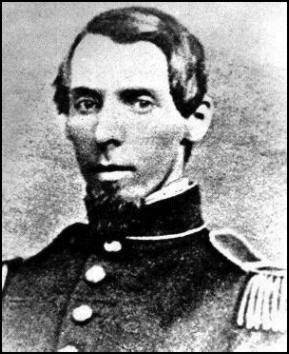|
Confederate Generals |
|
Brig. Gen. Samuel Garland, Jr. Born December 16, 1830 Lynchburg VA VMI 1849 Wounded at Williamsburg Mortally wounded and died September 14, 1862 South Mountain Buried Lynchburg VA |
 Brig. Gen. Samuel Garland, Jr. |
|
|
|
Pre-War Profession: Lawyer, Capt. of Lynchburg Home Guard militia. Samuel came from an old Virginia family (his great-uncle was President James Madison). In 1849 he graduated third in his class from the Virginia Military Institute. He then attended the University of Virginia and received his law degree in 1851. Garland set up a law practice in Lynchburg, Virginia, where he married and had one child, a son named Samuel. In late 1859 Garland helped organize the "Lynchburg Home Guard," which became part of the 11th Virginia Infantry, commanded by Garland. On June 12, 1861, his beloved wife died. Three months later his only child, little Samuel, also perished. Garland rose rapidly through the ranks and earned a reputation for fearlessness and coolness in battle. With reckless disregard for his own safety, Garland constantly exposed himself to the dangers of combat. Rumor attributed Garland's courage under fire to a death wish, a desire to join his wife and son. On the morning of September 14, 1862, while leading his brigade into battle at Fox's Gap, Garland was struck by a minie ball and died within minutes. His body was transported to Lynchburg and buried in the Presbyterian Cemetery on September 19, 1862. A monument to Gen. Garland was erected Sept. 11, 1993 on Fox’s Gap on South Mountain. Monument text:
Wise's Field on the morning of Sept. 14, 1862, Brigadier General Samuel Garland, Jr. C.S.A. of Lynchburg, Virginia fell mortally wounded while leading his men.
Erected by
Following John Brown’s raid on Harper’s Ferry, Garland helped to organize the Lynchburg Home Guard. The members of the guard elected him captain in 1859. When the Home Guard was mustered into state service in 1861, Garland was commissioned as a colonel, commanding the 11th Regiment of Virginia Volunteers. The Lynchburg Home Guard served as company G. Garland led the 11th Virginia at First Manassas, Dranesville and Williamsburg. Promoted to Brigadier General in May of 1862, Garland led a brigade under D. H.. Hill at Seven Pines, Gaines’ Mill and Malvern Hill. On the morning of September 14, 1862, General Garland’s Brigade was ordered to Fox’s Gap at South Mountain, Maryland. Garland deployed his troops in a defensive position behind a stone wall along the edge of a field. Soon his five thin regiments (about 1000 men) were under attack by the lead elements of Reno’s IX Corps; six Ohio regiments of Scammons Brigade of Cox’s Division. A total of about 3,000 Federals were pressing hard against Garland’s troops. The firing grew intense and Lt. George Crome was able to bring up a section of his Ohio Light Artillery and start throwing canister into the mix. General Garland moved to his left flank and encountered Col. Thomas Ruffin of the 13th North Carolina Regiment. “General,” Ruffin exclaimed, “why do you stay here? You are in great danger!” Garland replied, “I may as well be here as yourself.” “No” Ruffin argued, “it is my duty to be here with my regiment, but you could better superintend your brigade from a safer position.” Suddenly Ruffin was struck in the hip with a minnie ball. Garland turned to say something to an orderly when he too was struck by a bullet that tore through his chest and knocked him off his horse. Garland’s staff carried him down a road to the South Mountain Inn where he was laid on the front porch. Garland would soon die from his wound and later that day his body was carried down the steep road to Boonsboro and eventually to his home town of Lynchburg. General Samuel Garland is buried in the Presbyterian Cemetery in Lynchburg. Garland was only 32 years of age at the time of his death and was one of the most promising young officers in the Confederate Army, He led by example and had always shown conspicuous bravery under fire. He was wounded at Williamsburg and had two horses shot out from under him at Seven Pines. General Robert E. Lee eulogized Garland by calling him “That brave and accomplished young officer.” D. H. Hill called Garland“The most fearless man I ever knew.” Garland appeared to be a born leader with a sense of natural military abilities. Samuel Garland exemplified the best of the young boy generals serving in both armies during the Civil War, when men with little or no military experience were thrust into positions of leadership and excelled when forced by circumstances to make instant command decisions.
“Brave And Accomplished” memorializes General Samuel Garland. Jr. Much like that of his opposing commander, General Reno who was killed on the same field on the same day, his star burned brightly but all too briefly. Both of their stories, along with their gallantry, has been lost in the history books, perhaps overshadowed by the carnage of Antietam three days later. It is my determination that “Brave And Accomplished” and “Remember Reno”, will bring to light the heroic lives of Garland and Reno.
Bibliography:
Confederate Military History Vol. III
| |
|
Here's what's available. |
||
|
Johnson, Gen. Bradley T. - Confederate Military History - Maryland |
184 pgs. $15.00 
|
$15.00 
|
|
Rigdon, John C. Confederate Generals |
|
$35.00 
|

|

| |||||||||||||||||||||||||||||||||||||||||||||||||||||